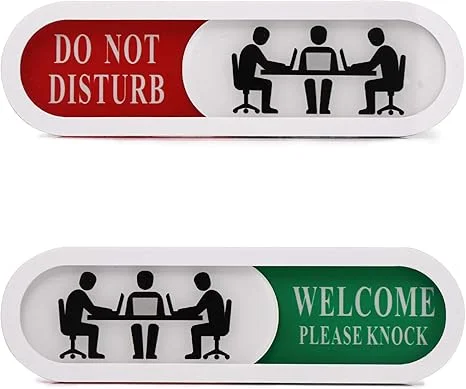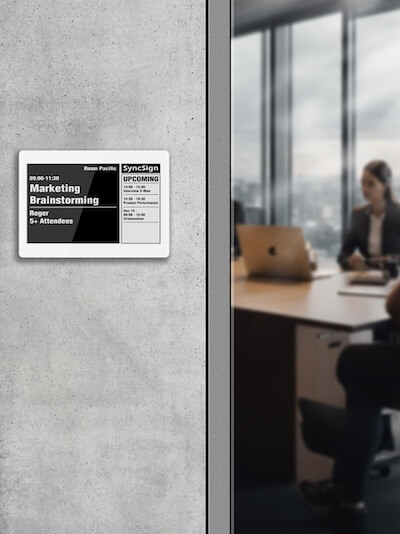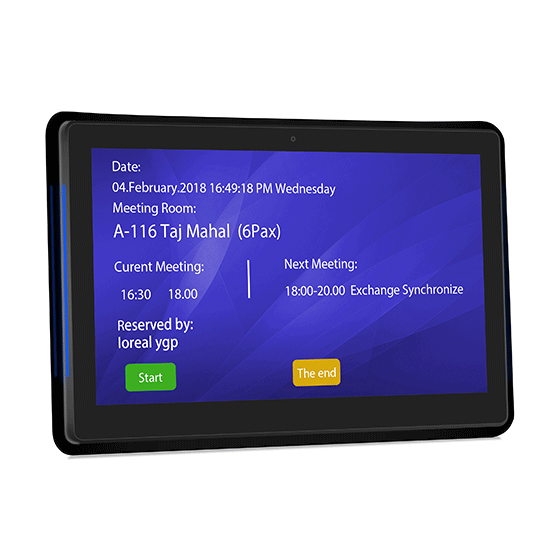
Choosing the Right Availability Sign for Your Meeting Rooms
In modern workplaces, managing meeting room availability is a crucial factor for productivity. Confusion over room bookings or double-scheduling can create friction in a busy office. To streamline this process, several types of meeting room status signs and displays have emerged, each catering to different needs and environments. Whether you want a simple manual solution or a fully integrated digital option, there’s a product that can fit your specific use case.
In this blog, we’ll explore three types of status signs:
1. Manual Status Signs: Simple and Effective
2. ePaper Display: A Smart, Wireless Solution
3. LCD Display: High-Tech but Power-Hungry
Each of these products has its own strengths and is suitable for different kinds of office environments. Let’s take a closer look at their features, benefits, and ideal use cases.
- Manual Status Signs: Simple, Budget-Friendly, and Quick -
Overview:
Manual status signs are straightforward tools that allow users to physically switch between “Busy” and “Free” modes. These are typically made of durable materials and require no power supply. A user simply flips or slides the sign to indicate room availability.
Key Features:
- Manual Control: No digital integration—users manually switch the sign as needed.
- Affordable: Low upfront costs, making it accessible for small offices or budget-conscious companies.
- No Power Requirement: Ideal for places where electrical outlets are sparse or installation complexity needs to be minimized.
Ideal Use Case:
Small offices, co-working spaces, or meeting rooms with low foot traffic will find manual status signs suitable. These environments don’t require constant scheduling or tracking, making the simple flip sign more than enough to manage room availability.
Limitations:
Manual status signs rely on users to remember to change the sign, which can lead to confusion or unintentional double-booking if someone forgets to update the status.

- ePaper Display: Smart, Wireless, and Integrated with Your Calendar -
Overview:
SyncSign is a wireless, e-ink Display that syncs with popular calendar systems like Google Workspace, Office 365, or Outlook. With this integration, meeting room status is updated automatically, and users can see real-time availability on the display. SyncSign also boasts wire-free installation and a long battery life, making it a low-maintenance option.
Key Features:
- Calendar Integration: Automatically syncs with your existing calendar system to display up-to-date room status.
- Wireless Installation: No need for complex electrical wiring, making installation quick and easy.
- Long Battery Life: The e-ink Display ensures that the device can run for months or even years without needing frequent battery replacements.
- Customizable Templates: You can tailor the display to suit your company’s branding or privacy needs, such as hiding meeting titles.
Ideal Use Case:
SyncSign is perfect for modern offices with frequent meetings, shared spaces, and multiple rooms to manage. Businesses that want to reduce scheduling conflicts and streamline meeting room usage will benefit from the automated system. This solution works particularly well in tech companies, law firms, and clinics where privacy and efficiency are priorities.
Limitations:
While SyncSign is highly efficient, the upfront investment may be higher than manual signs. However, the ease of use, lack of wiring, and low maintenance make it worth the investment for most organizations.

- LCD Display: High-Tech and Power-Dependent -
Overview:
LCD Displays are another digital solution for meeting room management, offering vibrant, dynamic screens that sync with your calendar system. Unlike SyncSign, LCD Displays require a constant power supply, which means they must be connected to a power source. Their large, bright displays make them visually appealing but come with additional installation and power-related challenges.
Key Features:
- Calendar Integration: Syncs with Google Calendar, Office 365, and other popular calendar systems.
- Bright and Clear Display: Offers a high-resolution, visually engaging interface that shows detailed room information.
- Customization: Can display room status, company branding, meeting details, and even additional media or announcements.
Ideal Use Case:
LCD Displays are ideal for high-traffic meeting rooms in larger, more tech-savvy organizations where visual impact and additional information (like video or detailed meeting agendas) are important. Conference centers, large corporate offices, and tech hubs may find this solution appealing due to its premium look and enhanced functionality.
Limitations:
The biggest drawback is the need for a continuous power supply, which makes installation more complicated and potentially expensive. Complex electrical deployment and higher energy consumption also make it less suitable for offices looking for a simple, low-maintenance solution.

- Conclusion: Picking the Right Solution for Your Office -
Each of these products addresses a specific need within meeting room management. Choosing the right solution depends on your budget, office environment, and technical requirements:
Manual Status Signs are perfect for small offices or co-working spaces where budget is a key concern, and room usage is low.
ePaper Displays offer a wireless, low-maintenance option for businesses that want calendar integration without the hassle of wiring and ongoing power costs.
LCD Displays are best for high-traffic environments where a bright, visually impactful solution is required, despite the need for complex installation.
By assessing your organization’s needs, you can find the best status sign solution to improve meeting room usage, reduce scheduling conflicts, and boost workplace productivity. Whether you choose a manual, wireless, or LCD option, each has the potential to enhance your office experience.
